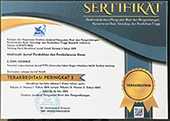The Implementation of Distance Learning during the Covid-19 Pandemic
Abstract
The implementation of learning is the most important part in improving the quality of education. The Covid-19 pandemic period is part of the challenge for education so that learning continues. The purpose of this study was to investigate in depth the implementation of distance learning during the Covid-19 pandemic. The method used in this research is qualitative with a case study approach. The research was conducted at Muhammadiyah Pakel Elementary School. The data sources in this study were teachers, parents, and students. Data collection techniques using structured interviews assisted with guidelines that are structured questions systematically. Data analysis using the Denzin & Licoln case study model assisted by atlas.ti software version 8. The technique used to improve the quality of research is source triangulation. The results of this study provide information that in the implementation of the implementation of distance learning there are three factors, namely policy, distance learning process, and human resource activeness. These three factors are novelty which can be recommendations for the three education centers in order to be part of improving the quality of distance learning education during the Covid-19 pandemic.
Keywords
Full Text:
PDFReferences
Abidah A, Hidaayatullah HN, Simamora R, Fehabutar D, Mutakinati L. 2020. The Impact of Covid-19 to Indonesian Education and Its Relation to the The Impact of Covid-19 to Indonesian Education and Its Relation to the Philosophy of “ Merdeka Belajar .” Stud Philos Educ. 1(1):38–49.
Akther U. 2016. Psychological Impact of Distance Education Technologies in Student â€TM s Personal Development . PSYCHOLOGICAL IMPACT OF DISTANCE EDUCATION. Int J Dev Educ Psychol. 1(2):203–211.
Amir LR, Tanti I, Maharani DA, Wimardhani YS, Julia V, Sulijaya B. 2020. Student perspective of classroom and distance learning during COVID-19 pandemic in the undergraduate dental study program Universitas Indonesia. Int J Multikultural Multireligious Underst. 7(6):1–8.
Apriyanti C. 2020. The parents role in guiding distance learning and the obstacle during covid-19 outbreak. J Ilm Pendidik Dasar. VII(2):68–83.
BPS-Statistics Indonesia. 2019. Telecommunication statistics in Indonesia. Sari E, Utoyo S, Anggraini L, editors. [place unknown]: BPS-Statistics Indonesia, Jakarta, Indonesia.
Darmawan D. 2009. Peningkatan Aksesibilitas “ 3 M-Mobile Learning ” sebagai Layanan Pendidikan. MIMBAR. 30(1):28–41.
Denzin NK, Lincoln YS. 2018. The sage handbook of qualitative research fifth edition. [place unknown]: SAGE Publications, Inc.
Essel R, Boateng-Owusu W, Saah AA. 2014. Effect of sistance learner-perception of course materials on access to learning for professional development: a case study of centre for continuing education, university of cape coast, ghana. Cent fo Distance Contin Educ. 3(3):1–5.
Keegan D. 2008. The impact of technologies on distance learning students. Francesco Agrusti.
Mahmudah FN, Cahya E. 2020. What Makes Employees Productive and Have High Performance ? Human Capital Investment in Universities. Asian J Educ Soc Stud [Internet]. 11(1):21–36. https://doi.org/10.9734/ajess/2020/v11i130281
Mesiono. 2010. Kebijakan pendidikan dan pengembangan sekolah (school development). J Tazkirah. 2(2):1–16.
Ngyen AV. 2017. The Impact of Online Learning Activities on Student Learning Outcome in Blended Learning. J Inf Knowledgement. 1(9):1–40.
Pemerintah Indonesia. 2020. Keputusan menteri pendidikan dan kebudayaan republik indoneisa nomor 719/P/2020 tentang pedoman pelaksanaan kurikulum pada satuan pendidikan dalam kondisi khusus. Jakarta: Sekretariat Negara.
Prasojo LD, Mukminin A, Mahmudah FN. 2017. Manajemen strategi human capital dalam pendidikan. Yogyakarta: UNY Press.
Rahmawati SD. 2009. Kendala pelaksanaan pembelajaran jarak jauh melalui internet pada mahasiswa PJJ S1 PGSD universitas negeri semarang. [place unknown].
Ramdhani A, Ramdhani MA. 2017. Konsep umum pelaksanaan kebijakan publik. J Publik [Internet]. 11(1):1–12. 2 www.jurnal.uniga.ac.id
Sahlberg P. 2020. Will the pandemic change schools? J Prof Cap Community. 5(3–4):359–365.
Sari W, Rifki AM, Karmila M. 2020. Pembelajaran Jarak Jauh Pada Masa Darurat Covid 19. J MAPPESONA.(1):12.
Stake RE. 2010. Qualitative research studying how thins work. United Sta. [place unknown]: A Division of Guilford Publications, Inc.
Suyahman. 2016. Analisis kebijakan pendidikan gratis di sekolah menengah atas dalam kaitannya dengan kualitas pendidikan menengah atas. J Pendidik Kewarganegaraan. 6(2):1047–1054.
Suyantiningsih. 2003. Sistem pendidikan jarak jauh interaktif: urgensi teknologi informasi dalam pendidikan jarak jauh (distance education). Din Pendidik. 10(1):1–12.
Syakdiyah A, Mahmudah NF, Wijayanti W. 2019. Active Learner Strategies in Era of Disruption : a Literature Review. Proc First Int Conf Progress Civ Soc. 317(1):165–168.
Yusnilita N. 2020. The impact of online learning: student’s views. ETERNAL (English Teach Journal). 11(1):57–61.
DOI: https://doi.org/10.18860/mad.v13i2.11330
Copyright (c) 2021 Madrasah: Jurnal Pendidikan dan Pembelajaran Dasar

This work is licensed under a Creative Commons Attribution-NonCommercial-ShareAlike 4.0 International License.





